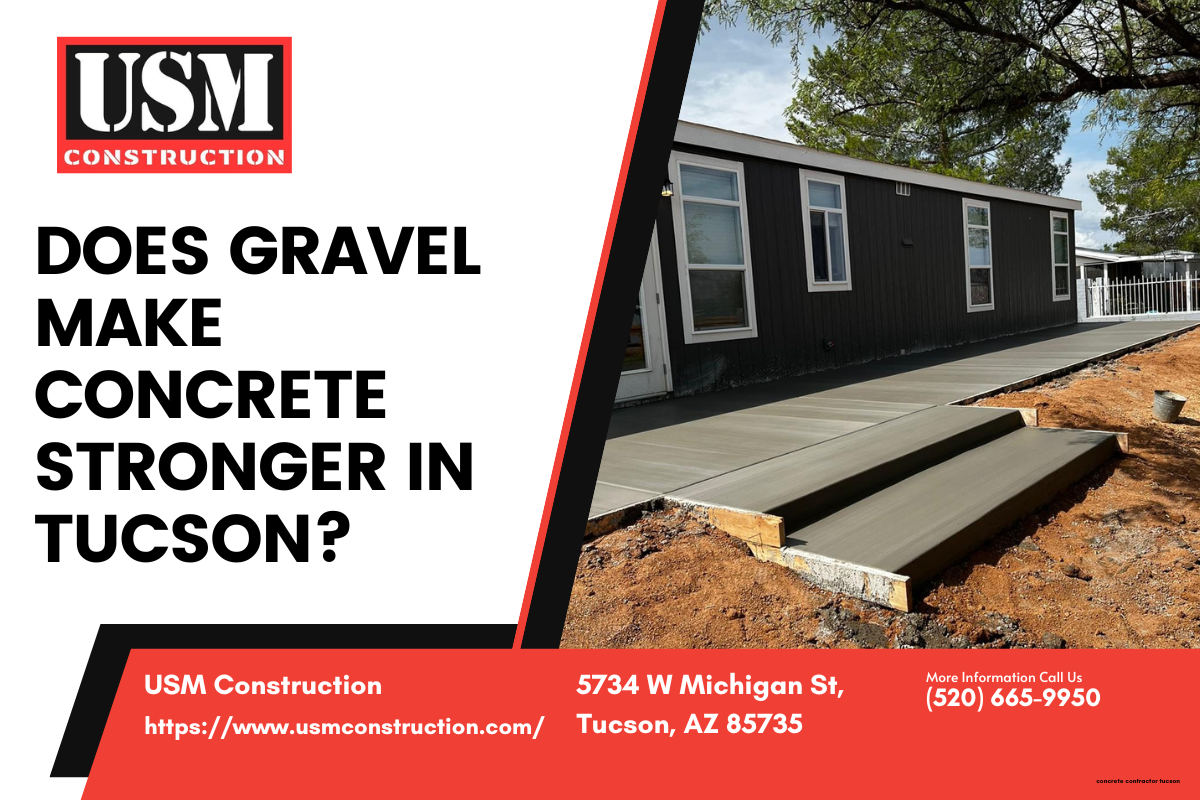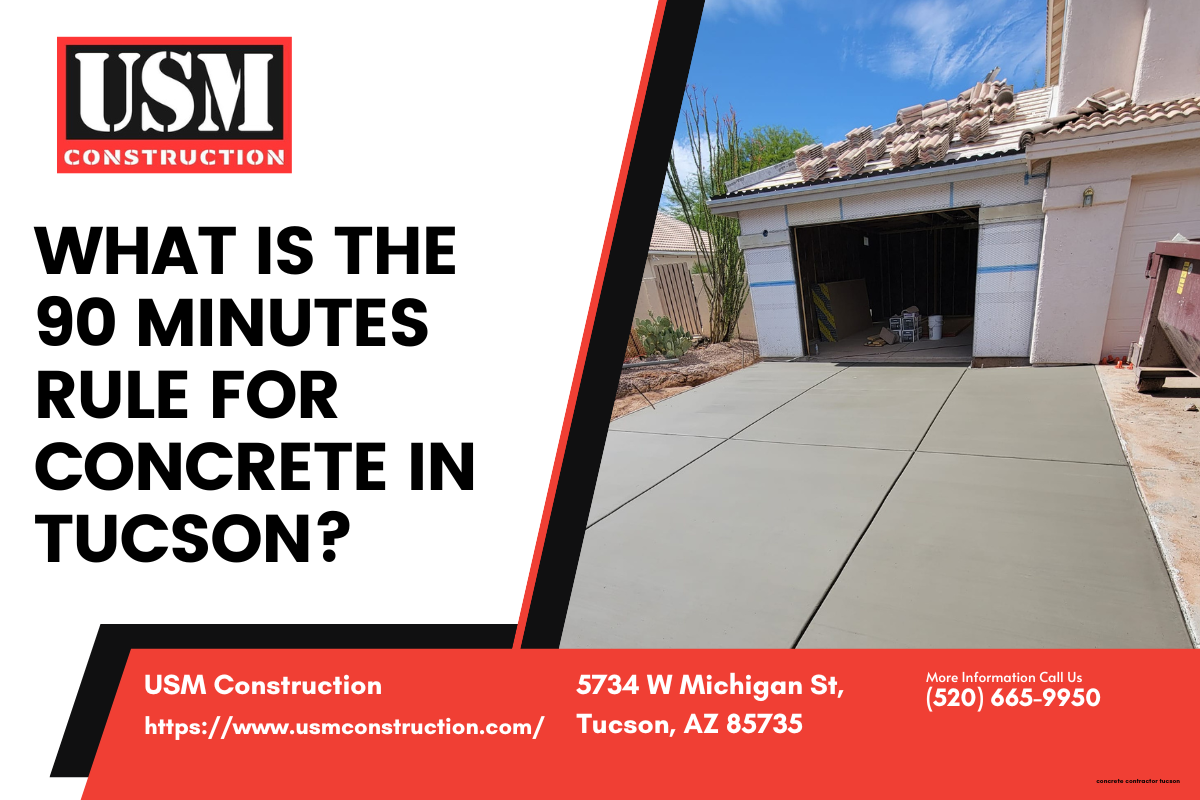TABLE OF CONTENTS
Yes, gravel is a critical component for strong concrete in Tucson, but its most important role isn’t as an ingredient in the mix—it’s as an engineered sub-base *under* the slab. For projects in Pima County, a properly installed gravel base is the single most important factor in preventing cracks and foundation failure caused by our region’s notoriously destructive caliche soil.
Beyond the Mix: Why the Ground Beneath Your Concrete is Tucson's Real Challenge
Here at USM Construction LLC, we get this question a lot. Homeowners in Oro Valley and business owners in Marana want to know the secret to a concrete driveway or foundation that won't crack under the brutal Sonoran Desert sun. They often focus on the concrete mix itself—the PSI strength, the type of aggregate, or the use of rebar. While those elements are certainly important, they don't address the root cause of most concrete failures in Southern Arizona.
The real enemy of long-lasting concrete in Tucson isn't the heat; it's the ground we build on. The core thesis for any successful project, from a simple patio in Sahuarita to a major commercial foundation, is this: For Tucson property owners, the strength of concrete lies not in the simple 'gravel vs. no gravel' debate, but in engineering a proper gravel sub-base to conquer the unique, destructive challenges of the region's native caliche soil.
Caliche 101: Understanding Tucson's Number One Foundation Foe
If you've ever tried to dig a hole in your yard around Tucson, you've likely met caliche. It’s that rock-hard layer of soil that feels like natural concrete. Scientifically, caliche is a soil accumulation of soluble calcium carbonate that precipitates and binds other materials such as gravel, sand, clay, and silt. According to geological surveys, this formation is common in arid and semiarid regions where annual precipitation is less than 26 inches per year—a perfect description of the Tucson valley.
While its hardness seems like a benefit, caliche is incredibly problematic for concrete slabs for two main reasons:
- It’s Impermeable: Caliche acts like a subterranean bowl, trapping water. When our monsoon rains hit, water that seeps around the edges of a concrete slab can't drain away. It gets trapped between the concrete and the caliche layer. This trapped moisture can cause soil expansion and hydraulic pressure, leading to heaving, shifting, and eventual cracking of the slab above.
- It’s Unstable When Wet: The clay and silt components within the caliche can expand significantly when saturated and shrink as they dry out. This constant cycle of expansion and contraction creates movement that a rigid concrete slab simply cannot tolerate, leading to stress fractures that compromise the entire structure. Pouring concrete directly on Tucson caliche soil is a recipe for premature failure.
This is why understanding Pima County soil types and concrete is paramount. Caliche soil and concrete foundation problems are one of the most common issues we address in foundation repair and replacement projects across the region.
The Engineered Solution: How a Gravel Sub-Base Protects Your Investment
So, if caliche is the problem, what is the solution? An engineered gravel sub-base. This isn't just a loose layer of rock dumped on the ground. A proper sub-base is a carefully planned and executed layer of specific material that serves several critical functions.
Creating a Vital Drainage Buffer
The primary benefit of a gravel sub-base is drainage. A compacted layer of 4 to 6 inches of crushed, angular gravel creates a "buffer zone" between your concrete slab and the impermeable caliche. The spaces between the gravel particles allow water from rainfall or irrigation to flow freely away from the underside of the slab, preventing it from getting trapped. This effectively neutralizes caliche's water-trapping threat and provides a stable, dry platform for your concrete.
Ensuring a Stable, Uniform Foundation
A properly prepared site involves more than just adding gravel. The process for a durable Tucson concrete driveway installation includes:
- Excavation: Removing the top layer of organic soil and a sufficient amount of the underlying caliche to achieve the required depth.
- Grading: Ensuring the excavated area has a slight, uniform slope to direct water away from the foundation.
- Gravel Installation: Laying the specified gravel, such as a 3/4" crushed angular rock.
- Compaction: This is a crucial step. Using a plate compactor, the gravel is pressed into a dense, interlocking base that won't shift or settle over time. Compaction of the gravel base for concrete slabs is non-negotiable for long-term durability.
The Role of Gravel *In* the Concrete Mix
While the sub-base is the hero of our story, the gravel *inside* the concrete mix—known as coarse aggregate—is also a key player. So, does gravel strengthen concrete when it's part of the mix? Absolutely.
Aggregate (a combination of sand and gravel or crushed stone) makes up 60-75% of the total volume of concrete. It provides bulk, reduces the amount of cement paste needed (which is good for controlling shrinkage), and forms a strong internal structure. High-strength concrete for commercial projects in Tucson will have a very specific mix design, dictating the aggregate size and concrete strength needed to achieve a target PSI (pounds per square inch), often 4000 PSI or higher.
Many ask about the "10/20/30/40 rule for concrete," which is a rough guideline for mixing (10% cement, 20% water, 30% sand, 40% gravel). While useful for small DIY concrete steps, this method lacks the precision required for a driveway or foundation. For guaranteed strength and consistency, using a professional ready-mix concrete from a Pima County supplier is always the superior option. The mix is computer-batched to precise specifications, accounting for factors like the high heat that affects the water-cement ratio for Arizona's climate.
Choosing the Right Fill: Angular vs. Smooth Gravel
When it comes to both the sub-base and the aggregate within the mix, the shape of the gravel matters. Does crushed gravel make concrete stronger than pea gravel? Yes, significantly.
- Angular, Crushed Gravel: This is the ideal choice. Stones that have been mechanically crushed have sharp, irregular edges. These edges interlock with each other and bond securely with the cement paste, creating a much stronger, more stable matrix. This angular gravel for stronger concrete interlock is essential for both the base and the mix.
- Smooth River Rock (or Pea Gravel): These stones are smooth and rounded. They tend to shift and slide against each other, much like marbles in a jar. They don't lock together well in a sub-base and can create weak points within the concrete mix itself. While sometimes used for decorative purposes, they are not recommended for structural applications like driveways or foundations in Tucson.
Comparing Your Foundation Options in Tucson
To make a confident decision, it's helpful to see a direct comparison of the options. This table breaks down the long-term implications of each approach.
Making the Right Choice for Your Needs
The optimal approach depends on the specific project. There isn't a single "best" answer, but there is a right solution for your goals, whether it's a residential or commercial concrete project.
The New Home Builder
For those building a new home foundation in Tucson, there is no substitute for a properly engineered foundation system. Your priority is lifetime stability and meeting all Pima County building codes. This means comprehensive soil testing and a foundation designed by an engineer. This will almost certainly involve significant caliche removal, installation of a compacted gravel sub-base, and a robust foundation type. For areas with particularly expansive soil, stem wall foundations offer excellent support and resistance to soil movement, making them an ideal choice. This approach is well-suited for unstable soil conditions, and alternatives like a post-tension slab vs. a traditional foundation should be discussed with your builder and engineer.
The Existing Homeowner
If you're replacing a cracked driveway or building a new stamped concrete patio, your goal is a permanent solution that fixes the cause of the previous failure. The temptation is to save money by skipping the site prep, but this will only lead to the new slab cracking in a few years. Insist that your contractor excavates the old, failed base and installs a new, compacted gravel sub-base. It is the most critical factor for the long-term durability of your new concrete and will protect your investment for decades.
The Commercial Property Manager
For large-scale commercial concrete services, such as parking lots, loading docks, or building pads, the focus is on structural integrity, load-bearing capacity, and minimizing long-term maintenance costs. For you, soil testing, a professionally engineered drainage plan, and a thick, compacted gravel sub-base are non-negotiable. Using high-strength concrete (e.g., a 4000 PSI mix) with the correct reinforcement (rebar) over a superior base is the only way to ensure the surface can withstand heavy traffic and the destructive forces of our local soil.
Ultimately, the strength and longevity of your concrete in Tucson depend far more on proper ground preparation than any other single factor. Contractor expertise with local soil conditions like caliche is the difference between a project that lasts five years and one that lasts fifty. A contractor who recommends pouring directly on the soil is cutting a corner that will cost you dearly in the long run.
At USM Construction LLC, we have built our reputation on engineering concrete solutions that are specifically designed to conquer the challenges of the Sonoran Desert. We understand caliche, we know the local codes, and we never compromise on the foundation. For a personalized assessment of your project and a free, comprehensive quote, contact our expert team today. Let's build something that lasts.


























